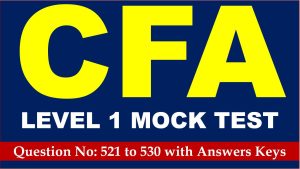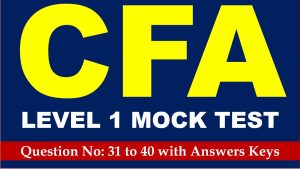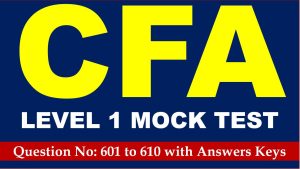Hi CFA Aspirants, welcome to AKVTutorials. Are you preparing for CFA Level 1, 2, 3 exams for making a career in CFA (Charted Financial Analyst). According to CFA Wikipedia, CFA The Chartered Financial Analyst (CFA) program is a postgraduate professional certification offered internationally by the American-based CFA Institute. A candidate who successfully completes the program and meets other professional requirements is awarded the “CFA charter” and becomes a “CFA charter holder”. Therefore, you need CFA Study Notes and CFA Level 1 Exam 37 Questions Bank Answer Keys AMBIPi.
In this article, you will get Free CFA Level 1 Mock Exam Practice Questions.
Free CFA Level 1 Mock Practice Exam Questions Bank
Free CFA Level 1 Practice Question No: 361:
Which measure of dispersion disregards the algebraic signs (plus and minus of each difference between X and the mean?
Option A: Standard deviation.
Option B: Variance.
Option C: Mean deviation.
Option D: Mean.
Option D: None of these answers.
Show/Hide Answer
Option C : Mean deviation.
The mean deviation is the mean of the absolute values of the deviations from the mean.
CFA Level 1 Exam Question No: 362:
The semiannually compounded rate is 10% quoted on an annualized basis. The equivalent annually compounded rate is:
Option A: 10.25%.
Option B: 10.5%.
Option C: 9.65%.
Option D: 10.1%.
Show/Hide Answer
Option A : 10.25%.
To solve such problems, think about investing a dollar for a year. The final amount should be the same under both the quotations. Under annually compounded rate, r, $1 grows to 1+r in 1 year.
Under semiannual compounding, it grows to (1+0.1/2)^2 = 1.1025. Since these two should be equal, we get 1+r = 1.1025, giving r = 10.25%. Note that the annually compounded rate must be larger than the semiannually rate, ruling out 9.65 automatically.
Free CFA Level 1 Mock Exam Question No: 363:
In hypotheses testing, what is the level of significance?
Option A: Symbolized by the Greek letter “alpha”.
Option B: All of these answers are true.
Option C: Selected before a decision rule can be formulated.
Option D: Value between 0 and 1.
Option E: Risk of rejecting the null hypothesis when it is true.
Show/Hide Answer
Option B : All the above a correct descriptions of the level of significance.
All the above a correct descriptions of the level of significance.
CFA Level 1 Free Practice Question No: 364:
If you deposit $10,000 into an account paying 6% per year, compounded semiannually, how much do you have in the account in 8 years?
Option A: $15,938.48.
Option B: $16,047.06.
Option C: $12,667.70.
Option D: $14,800.00.
Option E: $25,403.52.
Show/Hide Answer
Option B : $12,667.70.
On the BAII Plus, press 16 N, 6 divide 2 = I/Y, 10000 PV. 0 PMT. CPT FV. On the HP12C, press 16 n, 6 ENTER 2 divide i, 10000 PV, O PMT, FV. Note that the answer will be displayed as a negative number. Make sure the BAII Plus has the value of P/Y set to 1.
Free CFA Practice Question No: 365:
Tran Holten, a quantitative analyst with Smith, Kleen & Beetchnutty Brokerage, has just been informed of an important error in one of his recent statistical endeavors.
Specifically, in one hypothesis test, Mr. Holten rejected a null hypothesis that later was proven to be true. Which of the following best describes this type of error in hypothesis testing? Further, if the confidence level of the test were increased, would the probability of this error increase, decrease, or remain unchanged?
Option A: Type I error; decrease.
Option B: Type I error; increase.
Option C: Type II error; decrease.
Option D: Type I error; remain unchanged.
Option E: Type II error; remain unchanged.
Option F: Type II error; increase.
Show/Hide Answer
Option A : Type I error; decrease.
In this example, Tran Holten has incorrectly rejected a null hypothesis. This type of error in hypothesis testing is called a Type I error. In hypothesis testing, the Type I error is given much more attention than the Type II error. In most hypothesis tests, the probability of a null hypothesis is equal to the significance level of the test. A significance level of 0.01, for example, indicates that a 1% chance exists that the null hypothesis will be rejected when it is indeed true. Another way to think of the probability of a Type I error is to observe the following relationship:
{Probability of a Type I error = (1 – confidence level)]. For example, a confidence level of 95%
leaves a 5% probability of a Type I error occurring. If this confidence level were to increase to say, 98%, then the probability of a Type I error would reduce to 2%. As you can see, there is a relationship between the confidence level of a test and the probability of a Type I error.
If the confidence level of the test in this example were to increase, then the probability of a Type I error would decrease.
CFA Level 1 Sample Question No: 366:
You believe the stock of Microsquish reflects a 90% chance of a dismissal of its contractual liability suit. If the suit is dismissed, you expect the stock of Microsquish and its partner, AWOL, to rise. If the suit is not dismissed, both will fall in price. However, you think that AWOL’s stock only reflects a 60% chance of dismissal of this suit. What strategy would be optimal?
Option A: Sell both short.
Option B: Buy Microsquish.
Option C: Sell AWOL.
Option D: Buy AWOL.
Show/Hide Answer
Option D : Buy AWOL.
This is an example of the investment consequences of inconsistent probabilities. If the true probability of a lawsuit dismissal is only 60%, then AWOL’s stock is fairly valued, and Microsquish is overvalued. If the true probability is 90%, then Microsquish is fairly valued, and AWOL is undervalued. Your can thus construct a profitable risk-free strategy. You should buy AWOL, because at worst, the stock will be fairly valued. At best, it is undervalued. You could also simultaneously short Microsquish, because at best, it is fairly valued; there is a chance that it is overvalued.
Note that this example ignores all other factors other than the lawsuit.
Free CFA Level 1 Quiz Question NO: 367:
If the correlation coefficient between two variables equals zero, what can be said of the variables X and Y?
Option A: Highly correlated.
Option B: Not correlated.
Option C: Dependent on each other.
Option D: None of these answers are correct.
Option E: All of these answers are correct.
Show/Hide Answer
Option B : Not correlated.
ranges from -1 to +1. The closer it is to -1 or +1, the stronger the relationship. Closer it is to zero, the weaker.
Free CFA Level 1 Quiz Question NO: 368:
How much must you deposit today in order to withdraw $500 in 1 year, $700 in 3 years and $500 in 4 years, assuming your money earns 6.5% per year, compounded annually?
Option A: $1,200.00.
Option B: $1,503.27.
Option C: $1,240.80.
Option D: $1,421.95.
Option E: $1,437.64.
Show/Hide Answer
Option E : $1,437.64.
Solve this question by working 3 compound interest problems. On the BAII Plus, press 1 N, 6.5 l/Y, 0 PMT, 500 FV, CT PV, which yields $469.48. Then press STO 1. Then press 3 N, 700 FV, CPT PV, which yields $579.49. Then press + RCL
1 = STO 1. Then press 4 N, 500 FV, CPT PV, which yields $388.66. Then press +
RCL 1 = to see the answer. On the HP12C, press 1 n, 6.5 i, 0 PMT, 500 FV, PV.
Then press STO 1. Then press 3 N, 700 FV, PV. Then press RCL 1 + STO 1. Then press 4 n, 500 FV, PV. Then press RCL 1 + to see the answer. Note that the answer will be displayed as a negative number. Make sure the BAII Plus has the P/Y value set to 1.
Free CFA Practice Question No: 369:
A study of a company’s practice regarding the payment of invoices revealed that on the average an invoice was paid 20 days after it was received. The standard deviation equaled five days.
Assuming that the distribution is normal, what percent of the invoices were paid within 15 days of receipt?
Option A: 37.91%.
Option B: 86.74%.
Option C: 15.87%.
Option D: 34.13%.
Option E: None of these answers.
Show/Hide Answer
Option C : 15.87%.
z = (x-u)/sigma = 15 – 20/5 = -1.0. z = 1 is 0.3413. 1.0 – 0.8413 = 0.1587.
CFA Mock Exam Free Question No: 370:
Which of the following is/are discrete random variables? I. The height of a student selected at random from 217 students. II. The slot number where the ball comes to rest in a roulette wheel. III. The color of a playing card drawn at random from a pack. IV. The speed of a car tracked by the radar gun of highway patrol.
Option A: IV only.
Option B: II & III.
Option C: I, II & IV.
Option D: II only.
Option E: III only.
Option F: I, II & III.
Option G: I only.
Option H: I & II.
Show/Hide Answer
Option B : II & III.
A student’s height and the speed of a car can take values over a continuum and hence, are not discrete variables.



